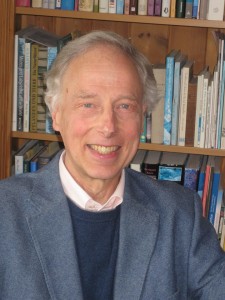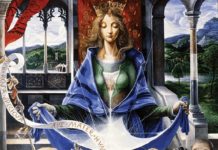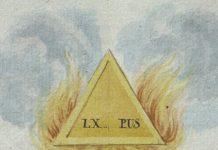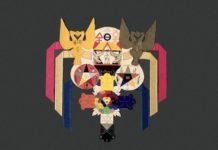Interview with Christopher McIntosh – author of ‘The Rosicrucians.’
Hello friends and readers. This week brings us to something special.
A new series will appear on this blog featuring various Rosicrucian scholars, authors and experts.
To kick off the series we’ve got Christopher McIntosh honoring us today.
Hi Chris, What got you interested in the Rosicrucian phenomenon?
 During the course of writing my first book, The Astrologers and their Creed, published in 1969, I kept coming across references to the Rosicrucians. I had only the vaguest idea of who they were and wanted to find out more, as this was obviously an important current within the esoteric traditions of the west, but it was difficult to find anything reliable that had been written about them in English, apart from A. E. Waite’s book The Brotherhood of the Rosy Cross, which was excellent as far as it went, if you could get used to Waite’s ponderous prose, but it was long out of date. So there was clearly a gap there. At the same time there was a lot of stuff in German – in terms of both printed books and manuscripts – and I had a command of German, so I decided that I would fill the gap and write a comprehensive history of Rosicrucianism in English. The result was The Rosy Cross Unveiled, later re-issued as The Rosicrucians. Later I returned to the subject of the Rosicrucians for my doctoral thesis, which was published as The Rose Cross and the Age of Reason.
During the course of writing my first book, The Astrologers and their Creed, published in 1969, I kept coming across references to the Rosicrucians. I had only the vaguest idea of who they were and wanted to find out more, as this was obviously an important current within the esoteric traditions of the west, but it was difficult to find anything reliable that had been written about them in English, apart from A. E. Waite’s book The Brotherhood of the Rosy Cross, which was excellent as far as it went, if you could get used to Waite’s ponderous prose, but it was long out of date. So there was clearly a gap there. At the same time there was a lot of stuff in German – in terms of both printed books and manuscripts – and I had a command of German, so I decided that I would fill the gap and write a comprehensive history of Rosicrucianism in English. The result was The Rosy Cross Unveiled, later re-issued as The Rosicrucians. Later I returned to the subject of the Rosicrucians for my doctoral thesis, which was published as The Rose Cross and the Age of Reason.
Have there been any exciting discoveries in your Rosicrucian journey?
By far my most exciting discovery – albeit one that must have disturbed quite a few people – was when I was researching into the history of the Hermetic Order of the Golden Dawn. If you remember, the co-founder of the Golden Dawn, Dr. Wynn Westcott, claimed to have received authority to found the order through a correspondence with a German woman called Fräulein Anna Sprengel, who was allegedly a high Rosicrucian initiate. When I examined the original letters in the library of Freemasons‘ Hall in London, I made the extraordinary discovery that the signatory of the letters was a man, not a woman! So the conclusion was inescapable. If the writer was a man then Westcott was lying when he claimed to have corresponded with a woman. If the writer was a woman then the correspondence was false. Either way it was pretty conclusive evidence that the correspondence was a forgery, and a highly inept forgery at that. I wrote about this in my article ‘Fräulein Sprengel’ and the Origins of the Golden Dawn (Aries, Vol 11, No. 2, 2011). I also satirised the episode in my short story The Strange Case of Fräulein Kaiser in my collection Master of the Starlit Grove and other stories (Vanadis Texts, 2014).
The interesting thing is that this discovery doesn’t invalidate the Golden Dawn itself. Forgery or not, the Golden Dawn created a highly effective system of symbolism and ritual, which has continued to thrive and given rise to numerous offshoots. So the conclusion is that one shouldn’t judge an order by its origins.
According to your research, did a circle of original Rosicrucians really exist?
Yes and no. There was a circle in Tübingen in the early 17th century, surrounding the theologian Johann Valentin Andreae, the Paracelsian physician Tobias Hess and the jurist Christoph Besold. These men had a vision of a new age, marked by a synthesis of science, religion and the arts and drawing on an ancient tradition of wisdom, and they looked towards a Europe healed of religious divisions. I believe they took the view that the best way to realise this vision was to cloak it in a legend, a mystery, and to launch this mystery into the collective mind of the age – the way one might drop a pebble into a pool, causing it to send out endless ripples. To this end they created a story about a German monk called Christian Rosenkreuz, who made a journey through the Middle East, acquiring wisdom from the sages of that region, and then came back to Germany and founded a secret brotherhood, the Brotherhood of the Rosy Cross. So, although I can’t disprove the existence of Christian Rosenkreuz, I believe that he and the original brotherhood were symbolic – a way of encapsulating the vision of the Tübingen circle.
What elements of the older tradition in particular do you feel are overlooked today by modern Rosicrucians?
Many modern Rosicrucian orders – although not all – are fixated on elaborate ceremonies, grades of initiation, complex systems of symbolism etc. Although these things can be valuable, the danger is that one loses touch with the real world. One of the people who most effectively realised the Rosicrucian vision in modern times was Rudolf Steiner, who insisted that Rosicrucian wisdom should not be confined to the head and heart, but should flow through the hands, into our manual activities and our daily actions. Hence the Steiner schools, the biodynamic agriculture, the homoeopathic medicine, the Anthroposophical style of architecture etc. I think all of that would have pleased Andreae and his circle in Tübingen.
Of all the books you have written, which is your favourite and why?
I would say my novel Return of the Tetrad. It tells the story of a spiritual quest, and the first-person narrator is loosely based on myself, although the events in it are to a large extent fantasy. It’s set in the 1960s and 70s in the early stage of my own spiritual quest, and when I re-read it now I recapture the excitement and magic of that time. London, where I then worked, was a paradise for someone on such a quest, with its rich libraries and bookshops and its thriving esoteric scene, in which I came to know many of the leading figures. Some of them appear in disguise in the novel. For example, the story involves a mentor figure called Gilbert North, who is loosely based on someone I knew at that time, a brilliant man who had been a follower of Aleister Crowley, and later went his own way and became a leading expert on mysticism and an advisor to several publishers in that area. The novel weaves many themes together: ritual magic, Rosicrucianism, reincarnation, the Tarot … but perhaps its most important message is that magic is all around us if we know how to perceive it.
Tell us about the current focus of your writing?
In recent years I have been doing less academic writing and more fiction. As the Rosicrucian writings prove, fiction can be a powerful way of changing people’s view of the world, especially if one works with deeper symbols, metaphors, archetypal themes. My fiction obviously reflects my own personal path, which in recent years has taken me into the Pagan movement. So most of the stories in my two recent collections, Master of the Starlit Grove and The Wyrde Garden, have a Pagan emphasis. In a completely different genre, I have also co-written a Cold War spy thriller, The Lebensborn Boy, under the pseudonym of Roy Havelland.
Which authors have influenced you particularly strongly?
Those who write about the borderland between the worldly and the other-worldly. One is the early 20th-century German writer Gustav Meyrink, author of The Golem and a number of other occult novels. Another is the brilliant Argentinian writer Jorge Luis Borges, who is absolutely sui generis. One of my favourites of his stories is Tlön, Uqbar, Orbis Tertius, which is a wonderful allegory of the Rosicrucian movement. Yet another is Charles Williams, who was a member of the Inklings circle in Oxford along with C. S. Lewis and J. R. R. Tolkien. Williams is one of the few British fiction writers who deal on a deep level with esoteric and supernatural themes. Much of what he wrote was influenced by his time as an active member of A. E. Waite’s Rosicrucian order. Another writer I should mention is my long-standing friend Lionel Snell, also known under his pen name of Ramsey Dukes, who writes uniquely thought-provoking, quirky and witty books about the interface between magic, philosophy, science and much else. He is one of those writers who cause you to see the world in a different way.
What attracted you to Paganism?
I believe I have always been Pagan at heart, but I have been led to this realisation by stages. When I lived in New York back in the early 1990s I attended a lecture by a rabbi who was a friend of mine, and at one point in the talk he said that the difference between monotheism and polytheism is that in the former history moves in a straight line towards some goal, such as the Second Coming, the Last Judgement or whatever, whereas in polytheism everything moves in a great circle. And in that moment I realised, in a flash of clarity, that I was a man of the circle not of the straight line. What I also came to realise while living in the US was that I’m a northern European and that the old gods of northern Europe are my gods. After I came back to Europe and settled in Germany I became actively involved in Paganism, and that has been my path ever since.
What are your current projects and your plans for the future?
Apart from continuing to write and give lectures, I am involved in various other activities. My wife, Dr. Donate McIntosh, and I have a small self-publishing operation called Vanadis, set up to publish our own books and essays. One of the things we have published is our new English translation of the Rosicrucian Fama Fraternitatis. We brought it out in 2014 to mark the 400th anniversary of the original publication, together with a new modern German translation by Donate. We have also recently started up a project in the German-speaking realm to provide spiritual care for sick Pagans, called Verdandihilfe. The name refers to the three Norns or goddesses of fate in the northern tradition, who correspond to past, present and future. Verdandi is the Norn of the present, who weaves the strands of fate together.
[easyazon_infoblock align=”right” identifier=”0877289204″ locale=”US” tag=”mystiaeter-20″]
Thanks Chris. Please give us details of relevant websites, links etc.
Here are the main relevant ones:
My personal website: www.ozgard.de
WordPress site: https://chrysdotnet.wordpress.com
Vanadis website: www.vanadis.org
Verdandi open Facebook group: https://www.facebook.com/Verdandihilfe/?fref=ts
Video about Return of the Tetrad: https://www.youtube.com/watch?v=KByMVVJjQpM
Author page on Amazon: http://www.amazon.com/Christopher-McIntosh/e/B00455JJB2
[easyazon_infoblock align=”right” identifier=”1438435606″ locale=”US” tag=”mystiaeter-20″]
Thank again Chris. I find your highlighting of Steiner representing one of the often overlooked aspects of the Rosicrucian tradition very helpful. Readers on this blog are particularly interested in anything in relation to Pansophy.
There you have it readers and friends. 🙂 you can grab a copy of ‘The Rosicrucians’ from amazon (aff link) especially if you are after a Rosicrucian primer that coves the most important aspects of its history. If you’ve only eve studied Rosicrucian monographs from your respective Order, ‘The Rosicrucians’ will give you a more objective overview.
One reviewer wrote “This books covers everything from the Fama (manifestos) to present day rosicrucian movements like AMORC, and the Fellowship… A very technical and scholarly book!”
For seasoned students of Rosicrucianism his ‘Rose Cross and the Age of Reason’ is the book for you. Especially if you are interested in the Golden Dawn, this book focuses on the German Golden Rosenkreuzer and Asiatic Brethren movements of the late 1700’s.
Thanks for reading guys, Sam.
Join our Facebook community here.
Return to my Rosicrucian Order homepage here..










